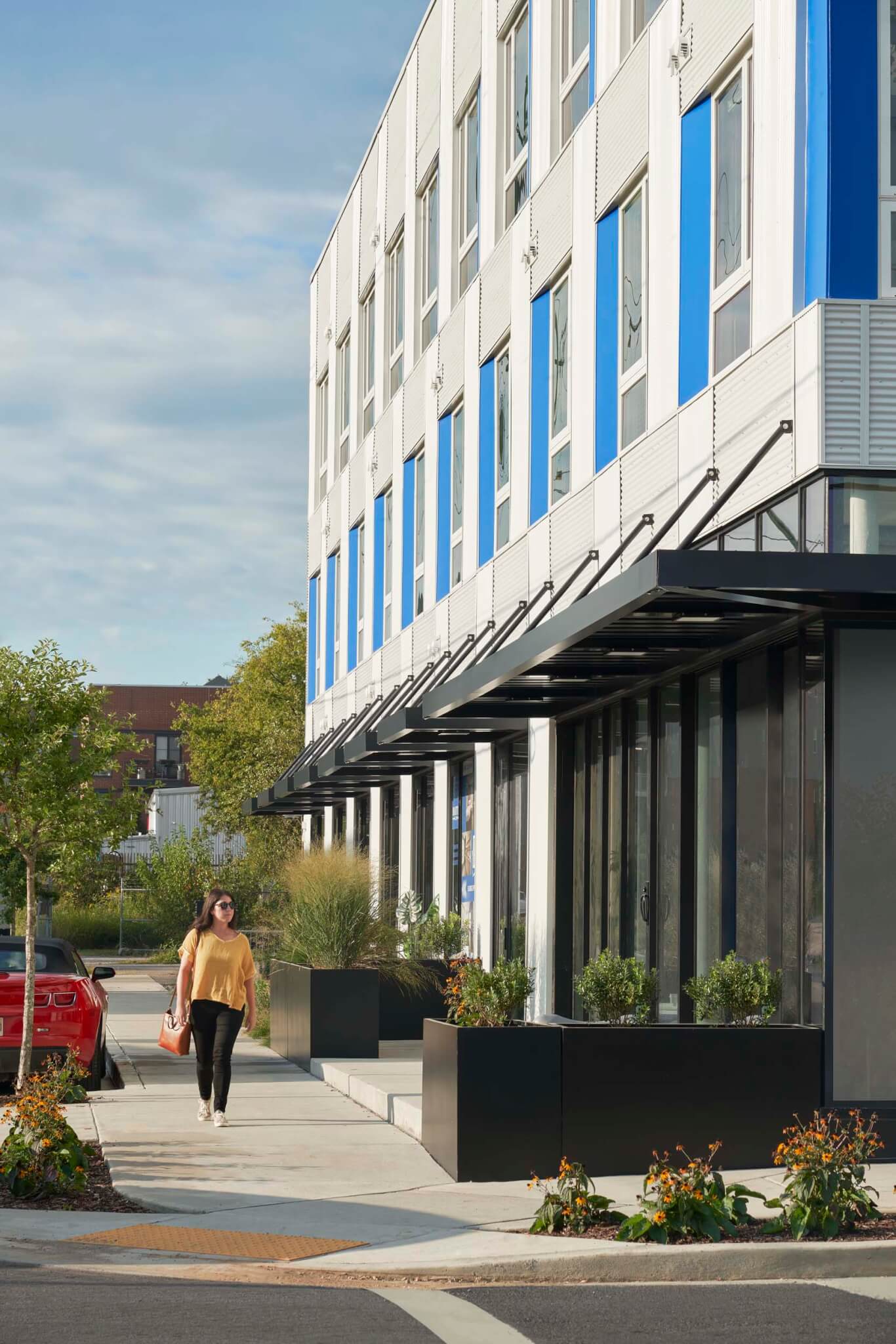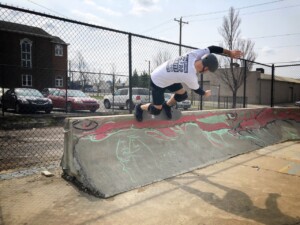When she’s home, a pastry chef living in workforce housing in Nashville has been giving cooking lessons in the shared kitchen on her floor, inviting her neighbors to join as she makes macarons.
In the text that follows I will suggest there are several ways to feel about this.
Such communal activity—spontaneous, not programmed—might very well be an ideal outcome for developers Eagle Rock Ventures and The Mathews Company and Nashville-based architecture and planning firm HASTINGS, who have now realized two wood-framed workforce housing complexes close to downtown. Both the eight-story, 174-unit Rutledge Flats in so-called So(uth)Bro(adway) and the three-story, 150-unit Martin Flats, on the other side of the “tourniquet” of Interstate 40 in Wedgewood-Houston, attempt to meet a need for affordable housing while still making a profit in a city with a per capita income of $45,000 and an average monthly rent of almost $1,400.

Natalie Gualy, Eagle Rock’s director of development, told me the company completed eight similar workforce complexes in Seattle—where public transit is frequent and off-street parking not required—before expanding in 2022 to Nashville and Asheville, North Carolina. The latter two are both places with good bones that have been splintered by segregation and urban renewal. “We look for cities with great neighborhoods and diverse economic drivers,” said Gualy, who earned master’s degrees in both architecture and real estate. “When you have those [drivers], you will have people willing to compromise a larger space for a more affordable unit.”
The unit is where the business model and the architecture begin. Eagle Rock has found a “sweet spot of square footage,” said HASTINGS principal David Powell, that pencils out. There are no utilities to pay. The wi-fi flows as freely as the tap water. These units are around 190 square feet, complete with a bed, kitchenette, toilet, shower, and window. Eight “live-work” units in each building include built-in desks.

Hemmed in by railroad tracks and surrounded by breweries, art galleries, and new market-rate apartment buildings, Martin Flats folds around a surprisingly serene interior courtyard—a three-story void landscaped in river birches and swishy grasses that serves as a patio for 150 people and doubles as a rain garden. Both buildings avoided wasting space for off-street parking: Martin, in a former industrial neighborhood where a major hosiery once employed a quarter of Nashville’s population, provides only a third of what’s required and Rutledge none, making it the first multifamily building downtown to take advantage of the no-more-minimum-requirements ordinance city council passed in 2022.

What might feel constrained to you could be convenient, even cozy, for some. But the units feel small. The shared, social-whether-you-like-it-or-not spaces embedded in both complexes are more generous spatially and materially. The compromise Gualy identified lies in the ways the architecture by necessity compels people to spend less time inside their units and more out of them: at work, at the park, and at the bar with colleagues or neighbors. Designed as they are to withstand incessant, inevitable turnover, the units imply impermanence, much like a dorm room. The pastry chef gives lessons—in part, at least—because she doesn’t have her own kitchen right now.
Developments like Martin and Rutledge “solve a need because they’re going to be cheaper than many other options for people,” Karen Kubey, a writer, editor, and professor at the University of Toronto, told me. “And it’s easier to get a lease.” Nashville is no more exempt from this need than any other U.S. city. From 2010 to 2020, it gained nearly 90,000 people. While productivity increased nationally that decade, wages stagnated and overall rents rose 36 percent. In Nashville, they rose 50 percent. The National Low Income Housing Coalition concluded there’s nowhere anymore in the U.S. you can afford a market-rate two-bedroom working 40 hours a week at the federal minimum wage. You’d need to clock at least 104 hours, leaving just 64 to sleep and polish your bootstraps.

In all of this, “workforce” housing ought to be consistently in scare quotes, as it describes homes for people whose jobs pay them 80 to 120 percent of the average monthly income. Historically, this was targeted to people with jobs in the public sector. But in this economy? Today it’s people with occupations as diverse as pastry chefs, nurses, and bus drivers. When I worked at the corporate-owned newspaper in Houston, where there have been more than 220,000 evictions since 2020, my salary meant I was also in the “workforce.” It is bad everywhere, though it is much worse elsewhere. The multiplicative housing and labor crises have created a situation where, in the Bay Area, school districts tried building housing for teachers, some of who pay more than 50 percent of their salaries on housing and still face commutes longer than an hour. In New York City, where the average rent in Manhattan surpassed $5,500 last summer, $50 million is being spent to renovate once-condemned “single-room occupancy” hotels just to create 500 new units. In Nashville, an affordable housing task force estimated the city would be 52,000 units short by 2030.

“Our country has enough resources to house everyone decently, but we see over and over that simply making an architectural move and making smaller units does not mean affordability, because housing in the U.S. is market driven,” said Kubey. “It only becomes affordable through regulation.”
She means through policy changes, like establishing the right to housing. Grassroots coalitions like People’s Action are trying to achieve this through the Homes Guarantee campaign. Likewise, a 2022 report from the Community Service Society lays out 20 smaller strategies New York City could pursue to support more social housing, including passing local taxes, increasing community ownership, strengthening code enforcement and securing tenants’ rights to representation, organizing, even supporting lease renewals. Because as Kubey said, “You don’t live in policy. You live in architecture.”

Atop HASTINGS’s Rutledge Flats, a 1,754-square-foot amenity roof deck opens out to a crowd of construction cranes and newly completed high-rises wallpapering the Nashville skyline. That’s where Powell kept directing my attention: elsewhere. That’s what this type of housing provides: valuable, desirable proximity in an extremely expensive world for the barista working on her first album or the empty nester who just off-loaded her burdens at an estate sale. The divorced dad. The college graduate. It’s not ideal. But the future, Powell seemed to imply, doesn’t have to end here.
Allyn West is a writer and editor in Houston and rural Kentucky. They are on X and Instagram @allynwest.









